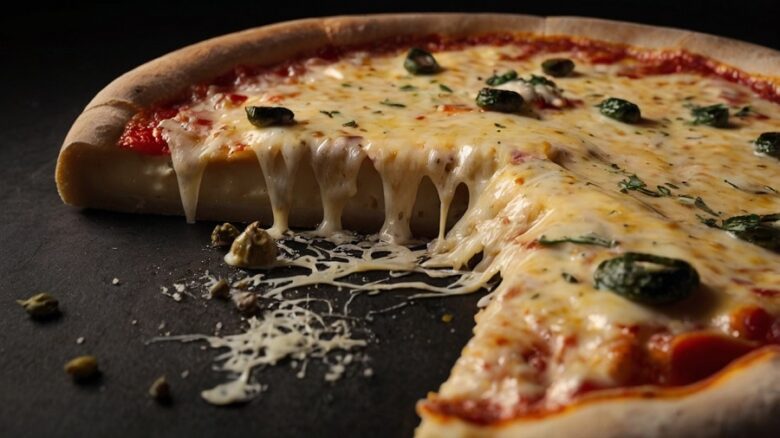Pizza is one of the most universally loved foods and the magic of a perfect slice often comes down to the creamy cheese. Think about that moment when you lift a hot slice and see golden cheese stretching-now that’s satisfaction at the moment. While sauce and crust do their part, the cheese is the game-changer. But not every cheese performs the same way. Some melt perfectly and stretch endlessly, while others bring hot flavors and creamy textures.
Whether you’re tossing dough in your home kitchen or find a local pizzeria, knowing which cheeses to use can transform your pizza from average to unforgettable. In this guide, we break down the best cheeses for pizza based on their melting behavior, taste, and versatility. You’ll find both classics and unique choices to fit every pizza style with Main street pizzeria & grille.

Let’s find the best flavorful lineup of pizza-perfect cheeses.
1. Mozzarella: The Crowd-Pleaser
Type: Semi-soft
Flavor Profile: Light, milky, slightly tangy and tasty
Why It Works: Mozzarella’s remarkable melt and well-known flavor make it deserving of its top spot. Its moderate fat content and high moisture content provide the perfect balance for that pleasant, stretchy, and delicious bite. When baked at high heat, it creates golden brown blisters and goes well with nearly any topping.
Ideal For: Neapolitan pies, New York-style, and classic margherita
Advice: To achieve a creamy finish, use fresh mozzarella, but be sure to drain it thoroughly.
Low-moisture mozzarella works well for sogginess without using an oven at home.
For a rustic presentation, tear into pieces rather than slicing.
Pre-shredded types that are high in starches and anti-caking chemicals should always be avoided.
2. Provolone: The Flavor Enhancer
Type: Semi-hard
Flavor Profile: Buttery with a slight tang
Why It Works: Provolone fills in when mozzarella seems a bit too subtle with its richer, more complex flavor. It melts easily and blends well with other cheeses to provide a golden sheen and creamy consistency.
Ideal For: Gourmet flatbreads, meat-heavy pies, and Philly-style pizzas
Advice: For sharpness, use aged provolone; for creaminess, use young provolone.
Mix well with mozzarella cheese.
To improve melting, grate or slice thinly.
3. Cheddar: The Bold Choice
Type: Hard
Flavor Profile: Sharp, nutty, and slightly earthy
Why It Works: Cheddar gives softer cheeses a dramatic contrast, depth, and color. It doesn’t stretch like mozzarella, but it still has a lot of flavor, especially when used in pizzas that are comfort food or barbecue.
Ideal For: Cheeseburgers,Cheese Wraps, morning pizzas, and BBQ chicken pizza
Advice: For a perfect melt, pair with mozzarella.
For a creamier, softer melt, use mild cheddar.
For a little extra zing, sharp cheddar makes a great topping.
4. Parmesan: The Finisher
Type: Hard, aged
Flavor Profile: Nutty, salty, umami-rich
Why It Works: Parmesan doesn’t melt well, but it’s a powerhouse of flavor that excels when used as a finishing touch. This aged cheese is packed with Mexican, enhancing the taste of every ingredient it touches. It lends depth to tomato sauces, brightens up pure vegetables, and provides a savory contrast to milder cheeses. Its grainy texture and delicious flavor make it a preferred choice for Toppings.
Best For: Garnishing Margherita or any classic pizza, Vegan pizzas, and even specialty with truffle oil and mushrooms
Tips:
- Grate fresh for maximum flavor and aroma-pre-shredded versions lose potency quickly.
- Sprinkle over your pizza right after baking while the surface is still hot so it integrates slightly without losing size and texture.
- Combine with mozzarella and provolone in blends for depth.
- Try shaving it into delicate curls for a gourmet finish with parmesan.
5. Ricotta: The Creamy Counterpoint
Type: Soft cheese
Flavor Profile: Light, slightly sweet, creamy
Why It Works: Ricotta adds a delicate creaminess to pizzas that need a softer, cooler balance. It’s not a melting cheese in the traditional sense, but its texture offers contrast against crispy crusts and more flavoured toppings. Ricotta is a staple on white pizzas and tasty deliseous Burgers with vegetables like spinach, mushrooms, and zucchini. Its subtle Hotness also allows it to shine on dessert pizzas with Cold drinks or fruits.
Best For: White pizzas, veggie pies, dessert pizzas, or pizzas with caramelized onions, garlic and fresh herbs
Tips:
- Use in dollops rather than spreading-this preserves the texture and appearance.
- Combine with perfect herbs, garlic, or lemon zest for an herbed ricotta twist.
- For a richer experience, use whole milk ricotta.
6. Fontina: The Underappreciated Gem
Type: Semi-soft to semi-hard
Flavor Profile: Mildly nutty, earthy, creamy
Why It Works: Fontina is a luxurious and Unique, lesser-known cheese that deserves more attention. It has a high fat content with less protein, making it exceptionally creamy and flavorful when melted. This makes it ideal for gourmet-style pizzas, especially those with subtle toppings like mushrooms, herbs, or truffle oil. Fontina’s cheese melted in a few minutes and it was very delicious.
Best For: Mushroom or truffle pizzas, white sauce pizzas, gourmet veggie combinations, and upscale flatbreads
Tips:
- Use with mozzarella to boost meltability while preserving its rich and unique taste.
- Choose Italian Fontina (Fontina Val d’Aosta) for authentic flavor-American varieties tend to be milder.
- Pairs well with fresh rosemary, thyme, and roasted garlic with proper test.
- Try using it in combination with taleggio or gruyère for even more attraction.
7. Gouda: The Sweet Surprise
Type: Semi-hard
Flavor Profile: Sweet, creamy, slightly smoky
Why It Works: Gouda, Generally in its smoked form, is a unique and delightful addition to pizzas. It melts evenly and brings a subtly sweet and creamy base that complements robust and bold toppings. Its rich, buttery undertone pairs wonderfully with smoky texture, giving your pizza an added layer of best flavors. The caramel notes in aged Gouda work well with creamy sauces, while the younger varieties offer a perfect touch beautifully. Gouda is often underrated in pizza making but deserves a spot among your top choices for its versatility and crowd pleasing profile.
Best For: Pulled pork, BBQ chicken, and bacon pizzas, or any pizza with a smoky, savory profile
Tips:
- Use aged Gouda sparingly due to its stronger and delicious flavor.
- Pair with sweet sauces like BBQ or honey made for a balanced test.
- Try combining it with mozzarella for a more elastic melt a few times.
- Delicious garlic-bread slices for even heat distribution with perfect shape.
- Excellent pizza varieties are inspired by southern or smoked cuisine.
8. Goat Cheese: The Tangy Twist
Type: Soft cheese
Flavor Profile: Tangy, earthy, creamy
Why It Works: Goat cheese is for those who love bold flavors. It brings a pleasant tang that brightens the overall flavor of a pizza, adding a contrast to rich meats or earthy vegetables. Though it doesn’t melt into a stretchy texture, it softens beautifully into creamy pockets. Goat cheese is often featured on gourmet pizzas, where the goal is to mix textures and elevate taste with fresh greens, fruits, or drizzle finishes. Its lower fat and sodium content also make it a more health-conscious option.
Best For: Veggie pizzas, beet and arugula combinations, Mediterranean styles, or pizzas topped with honey or balsamic glaze
Tips:
- Crumble over pizza after baking to preserve its texture and flavor.
- Works well with figs, spinach, or caramelized onions for sweet-savory contrast.
- Pair with other soft cheeses like ricotta or feta for a complex cheese blend.
- Add just before baking if you prefer a slightly melted and creamier texture.
- Great option for those seeking lactose-sensitive alternatives.
9. Blue Cheese: The Funk Factor
Type: Veined, soft cheese
Flavor Profile: Strong, salty, pungent
Why It Works: Blue cheese is bold and unapologetically flavorful. Its intense aroma and salty tang can transform a simple pizza into a gourmet masterpiece when used thoughtfully. It doesn’t melt completely but softens into creamy, concentrated bursts. This cheese pairs incredibly well with spicy, sweet, or earthy ingredients and brings a restaurant-quality flavor to any homemade pie. Fans of gourmet pizzas swear by its ability to add depth to every bite.
Best For: Buffalo chicken, steak and arugula, fig-based pizzas, pear and walnut combinations, or mushroom-heavy recipes
Tips:
- Use sparingly-too much can overpower the dish.
- Pair with milder cheeses like mozzarella or fontina to tone down the intensity.
- Sprinkle after baking or in the last few minutes to avoid overwhelming aroma.
- Try with spicy toppings like hot honey or chili flakes for a unique twist.
- Ideal for elevating meat-based or gourmet-style pizzas.
10. Burrata: The Luxurious Option
Type: Fresh, soft cheese
Flavor Profile: Buttery, rich, fresh
Why It Works: Burrata is the crown jewel of pizza cheeses when elegance and indulgence are on the menu. A fresh Italian cheese made from mozzarella and cream, it features a soft, outer mozzarella shell that encases a luscious, creamy center. This cheese doesn’t melt in the traditional sense but rather softens and oozes decadently, making it perfect for post-bake applications. When added to a hot pizza, Burrata slowly spreads its creamy interior, turning each slice into a gourmet masterpiece. Its rich texture contrasts beautifully with crisp crusts and acidic toppings like tomato or balsamic glaze.
This cheese is a showstopper, often used in Instagram-worthy creations. Burrata complements fresh ingredients like basil, heirloom tomatoes, prosciutto, or even arugula with lemon vinaigrette. While it’s not a staple cheese for every pie due to its luxurious cost and limited shelf life, when used thoughtfully, it elevates the entire pizza experience.
Best For: Margherita, heirloom tomato, and basil pizzas, prosciutto and arugula pizzas, white pizzas with garlic oil, or any artisan pizza where you want to impress guests
Tips:
- Always add burrata after baking to preserve its soft texture and prevent it from breaking apart under heat.
- Serve immediately for the best flavor and consistency-it’s meant to be enjoyed fresh.
- Tear gently over the top of the pizza or place whole in the center and cut tableside for dramatic presentation.
- Drizzle with olive oil or balsamic glaze to highlight its creamy richness.
- Pair with light wines or sparkling water for a fine dining-style meal.
The Science of Cheese Melting
Understanding the science behind how cheese melts is crucial for creating the perfect pizza experience. Different cheeses behave uniquely under heat due to their composition. At Main Street Pizzeria & Grille, we’re passionate about not just flavor—but the function of every ingredient.
Moisture, Fat & Acidity—The Melting Equation
- High-moisture cheeses like fresh mozzarella give that iconic stretch and gooey texture—no wonder they’re a staple on traditional pies.
- High-fat cheeses such as gouda or fontina melt into rich, creamy pools that enhance mouthfeel and richness.
- Acidity matters too: lower acidity helps cheese melt smoothly, while high acidity can cause it to separate or turn grainy.
Protein Structure & Aging
The way proteins bond also influences meltability. Tightly bonded proteins (like in Parmesan) resist melting, while cheeses with looser structures (like brie or mozzarella) melt more easily.
Heat matters! Cheese that’s heated too quickly or at too high a temperature can separate into oil or burn, ruining both texture and taste.
Aged vs. Young Cheeses
Younger cheeses typically melt better due to higher moisture content. Aged cheeses like sharp cheddar or Parmesan are drier and packed with flavor—great for topping or blending, not as base layers.
The Takeaway:
For the ultimate melt and flavor, mix high-melt cheeses with bold, lower-melt varieties. It’s all about balance—and at Main Street Pizzeria & Grille, that’s the secret behind every beautifully melted, flavorful pie we serve.
Creating the Perfect Cheese Blend
The best pizzas often use a blend of cheeses to get the ideal flavor and melt. Here are a few tried-and-true combos:
- Mozzarella + Provolone: Classic pizzeria blend
- Mozzarella + Cheddar + Parmesan: Perfect for complex flavors
- Fontina + Mozzarella + Ricotta: Creamy and rich
- Mozzarella + Blue Cheese + Gouda: Bold and smoky
Regional Cheese Preferences in the U.S.
- East Coast (NY/Philly): Traditional mozzarella with provolone accents
- Midwest (Chicago-style): Deep dish loves layers of mozzarella and cheddar
- West Coast (California): Goat cheese, ricotta, and fontina for gourmet pies
- South: BBQ pizzas with smoked gouda or cheddar blends
Knowing your region helps cater to local palates, especially for pizza shops and food businesses.
Tips for Home Cooks
- Preheat properly: A hot oven (ideally 500°F) ensures better melt and crust.
- Dry fresh cheeses: Pat down fresh mozzarella or burrata to avoid soggy crusts.
- Don’t overload: Too much cheese can prevent even melting.
- Experiment: Try different combos based on toppings.
Health Considerations
If you’re watching calories or fat content:
- Low-fat mozzarella is widely available and still melts well.
- Ricotta and goat cheese are lighter in fat and sodium.
- Use Parmesan and blue cheese as accents, not bases.
Final Thoughts
Pizza is a canvas, and cheese is the brushstroke that defines its identity. Whether you’re sticking with the classics or exploring bold, unexpected pairings, choosing the right cheese can elevate your pizza game to new heights.
At Main Street Pizzeria & Grille, we believe the beauty of pizza lies in its adaptability. With the right knowledge and a bit of experimentation, you can craft a cheese combination that’s not just delicious—but unforgettable.
So next time you’re planning pizza night, skip the generic cheese mix and think about what kind of experience you want to create. The best cheese for pizza isn’t always just one- it’s the one that brings your entire creation to life.
Let your tastebuds lead the way. We’ll bring the fire.




